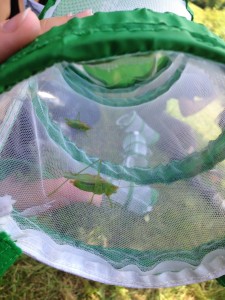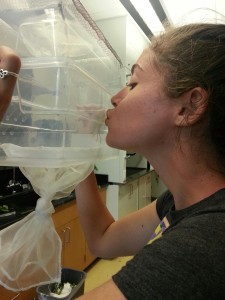Today was a lesson in patience, perseverance, and thermoregulation.
With the temperatures forecasted into the 90s and the knowledge that crickets chirp more often early in the morning, we left the lab early to beat the heat and catch some crickets.
As a quick aside, our grasshoppers happen to belong to the one Genus of grasshoppers that doesn’t use sound. At all. Which means that the first task of today’s collecting adventure was to release them.
We drove to the field where we’ve had good cricket luck, set our grasshoppers free, and started looking. There was only one chirping male near the roadside, and we have suspicions that it was a cricket who had outsmarted us before. Naturally, we were determined to catch him.
“Moby Cricket,” as Dana so aptly named him, apparently had other plans. As before, he advertised his little cricket heart out until we got too close. Then he stopped. It turns out that crickets are very sensitive to vibrations in the air—it’s how they detect predators. And, of course, their first response is to become silent so they’re more difficult to find. Which works. Very, very well. After what seemed like hours of playing this Cat and Mouse game, there were some uprooted plants, a handful of rather colorful words, and three very frustrated field biologists.
Forfeiting this battle to the cricket, we decided to cut our losses and try a different site.

SU’s South campus had been suggested by a few other ecology folks with research fields down there. According to our sources, there should have been crickets by the boatload. Maybe we were in the wrong field, but there was barely a katydid to speak of, much less a cricket.
Desperate to go home with some invertebrate loot, we had a serious brainstorming session.
Crickets prefer locations with water access, so we drove to the pond at Barry Park. In retrospect, a pond was a bit overkill, but we were willing to try anything. Although we struck out cricket-wise, we were fortunate enough to hear a new species of katydid hiding in the cattails near the pond, and these guys were LOUD!
Even though their calls are conspicuous, these new katydids (later identified as Gladiator Meadow Katydids) are sneaky. They hang out on large stems of cattails and other plants, but when they detect something nearby, they not only stop calling but shimmy around to the opposite side of the stem. This resulted in several instances of, “I know he’s six inches from my face, but I can’t see him!”

We eventually got the hang of finding them, and after a couple hours of stalking katydids interspersed with shade breaks (the temps were approaching 90 by now, and feeling much hotter), we had 10 of our Gladiators and felt rather pleased with ourselves.

Total bug count as of July 15: 33
1 adult two-striped grasshopper (just in case he does make sounds), 2 Spring field crickets, 2 True katydids, 2 Bush katydids (unk. spp.), 4 Eastern swordbearers (one of which is now an adult and quite pretty!), 12 Roesel’s katydids, 10 Gladiator meadow katydids, Cicadas soon…?
